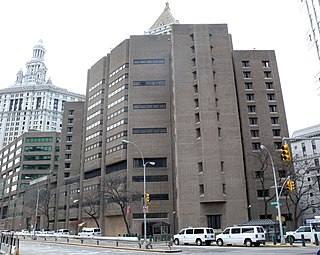Related Research Articles

The Attica Prison riot took place at the state prison in Attica, New York; it started on September 9, 1971, and ended on September 13 with the highest number of fatalities in the history of United States prison uprisings. Of the 43 men who died, all but one guard and three inmates were killed by law enforcement gunfire when the state retook control of the prison on the final day of the uprising. The Attica Uprising has been described as a historic event in the prisoners' rights movement.

George Lester Jackson was an American author, revolutionary, and prisoner. While serving an indeterminate sentence for stealing $70 at gunpoint from a gas station in 1961, Jackson became involved in the Black power movement and co-founded the prison gang Black Guerrilla Family.

Attica Correctional Facility is a maximum security prison campus in the Town of Attica, New York, operated by the New York State Department of Corrections and Community Supervision. It was constructed in the 1930s in response to earlier riots within the New York state prisons.

Rikers Island is a 413-acre (167.14-hectare) prison island in the East River in the Bronx that contains New York City's largest jail.
Auburn Correctional Facility is a state prison on State Street in Auburn, New York, United States. It was built on land that was once a Cayuga village. It is classified as a maximum security facility.
A prison riot is an act of concerted defiance or disorder by a group of prisoners against the prison administrators, prison officers, or other groups of prisoners.

The Tombs was the colloquial name for Manhattan Detention Complex, a former municipal jail at 125 White Street in Lower Manhattan, New York City. It was also the nickname for three previous city-run jails in the former Five Points neighborhood of lower Manhattan, in an area now known as the Civic Center.

William C. Holman Correctional Facility is an Alabama Department of Corrections prison located in Atmore, Alabama. The facility is along Alabama State Highway 21.

The Metropolitan Detention Center, Brooklyn is a United States federal administrative detention facility in the Sunset Park neighborhood of Brooklyn, New York City. It holds male and female prisoners of all security levels. It is operated by the Federal Bureau of Prisons, a division of the United States Department of Justice.

The New York City Department of Correction (NYCDOC) is the branch of the municipal government of New York City responsible for the custody, control, and care of New York City's imprisoned population, housing the majority of them on Rikers Island. It employs 7,060 uniformed officers and 1,727 civilian staff, has 543 vehicles, and processes over 100,000 new inmates every year, retaining a population of inmates of around 6,000. Its nickname is New York's Boldest. Its regulations are compiled in title 39 of the New York City Rules.

The Oklahoma State Penitentiary, nicknamed "Big Mac", is a prison of the Oklahoma Department of Corrections located in McAlester, Oklahoma, on 1,556 acres (6.30 km2). Opened in 1908 with 50 inmates in makeshift facilities, today the prison holds more than 750 male offenders, the vast majority of which are maximum-security inmates. They also hold many death row prisoners.

The Massachusetts Correctional Institution at Concord (MCI-Concord) was a medium security prison for men located in Concord, Massachusetts in the United States. Opened in 1878, it was the oldest running state prison for men in Massachusetts. It was under the jurisdiction of the Massachusetts Department of Correction. The facility had a total capacity of 614 general population beds, but with a long-term decline in the number of men incarcerated for the entire state, the population as of January 2024 had decreased to about 300, which made Governor Maura Healey announce a plan to close the prison in the summer of that year and transfer the remaining prisoners to other facilities.

The New York State Department of Corrections and Community Supervision (NYSDOCCS) is the department of the New York State government that administers the state prison and parole system, including 42 prisons funded by the state government.

The Vernon C. Bain Correctional Center was an 800-bed jail barge used to hold inmates for the New York City Department of Corrections. The barge was anchored off the Bronx's southern shore, across from Rikers Island, near Hunts Point. It was built for $161 million at Avondale Shipyard in Louisiana, along the Mississippi River near New Orleans, and brought to New York in 1992 to reduce overcrowding in the island's land-bound buildings for a lower price. Nicknamed "The Boat" by jail staff and inmates, it was designed to handle inmates from medium- to maximum-security in 16 dormitories and 100 cells.

The Metropolitan Correctional Center, New York is a temporarily closed United States federal administrative detention facility in the Civic Center of Lower Manhattan, New York City, located on Park Row behind the Thurgood Marshall United States Courthouse at Foley Square. It is operated by the Federal Bureau of Prisons, a division of the United States Department of Justice.

The GEO Group, Inc. (GEO) is a publicly traded C corporation that invests in private prisons and mental health facilities in the United States, Australia, South Africa, and the United Kingdom. Headquartered in Boca Raton, Florida, the company's facilities include immigration detention centers, minimum security detention centers, and mental-health and residential-treatment facilities. It also operates government-owned facilities pursuant to management contracts. As of December 31, 2021, the company managed and/or owned 86,000 beds at 106 facilities. In 2019, agencies of the federal government of the United States generated 53% of the company's revenues. Up until 2021 the company was designated as a real estate investment trust, at which time the board of directors elected to reclassify as a C corporation under the stated goal of reducing the company's debt.
Corrective Services NSW (CSNSW) is an executive agency of the Government of New South Wales, Australia. CSNSW is responsible for the state's prisons and a range of programs for managing offenders in the community. The state has 36 prisons, 33 run by CSNSW and three privately operated. The agency traces its origins back to 1788, when New South Wales was founded as a penal colony.

Jerome "Jerry" Rosenberg was a New York State convict, mobster, and jail house lawyer. He was incarcerated for 46 years, longer than any other prisoner in New York State history. Rosenberg was sentenced to death for his involvement in the 1962 double homicide of two New York City police officers during a robbery carried out with two other Mafia-connected gangsters. His sentence was commuted to life in prison in June 1965, after capital punishment was abolished in New York. Rosenberg went on to become the first New York State inmate to earn a law degree and in turn gave legal advice to several inmates, including the leaders of the Attica Prison riot. A book was written about Rosenberg and his time in prison which was adapted into a 1988, made-for-TV movie, Doing Life, starring Tony Danza.

The State Correctional Institution atCamp Hill is a Pennsylvania Department of Corrections prison in Lower Allen Township, Cumberland County, near Camp Hill in Greater Harrisburg. Its current superintendent is Michael Gourley. It has over 2,000 inmates.
Incarceration in Oklahoma is how inmates are rehabilitated and reformed. Incarceration in Oklahoma includes state prisons and county and city jails. Oklahoma has the second highest state incarceration rate in the United States. Oklahoma is the second in women's incarceration in the United States. After becoming a state in 1907, the first prisons were opened and reform began.
References
- 1 2 "The New York City Department of Correction Welcomes its New Commissioner". Correction Sidelights. www.correctionhistory.org. January 1966.
- 1 2 Mack, Willie (October 1, 2020). ""Traitors In Our Midst": Race, Corrections, and the 1970 Tombs Uprising". The Gotham Center for New York City History.
- ↑ Thompson, Heather Ann (21 March 2019). "How a Series of Jail Rebellions Rocked New York—and Woke a City".
- ↑ Pallas, John; Barber, Bob (1972). "From Riot to Revolution". Issues in Criminology. 7 (2): 1–19. ISSN 0021-2385.
- ↑ Ferretti, Fred (12 October 1971). "CITY TO USE FORCE IN A PRISON RIOT". The New York Times.
- ↑ Carroll, Maurice (20 November 1971). "McGrath Quits Jail Post; Says He Was Not Ousted". The New York Times.
- ↑ Fowler, Glenn (21 January 1988). "George F. McGrath, 70, Is Dead; Ex-Correction Chief in New York". The New York Times.